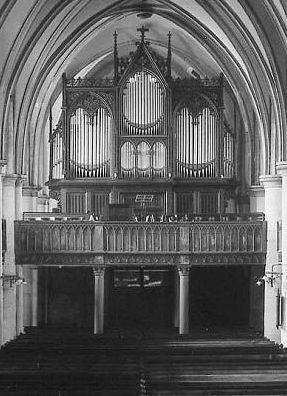Ausführliche Beschreibung der vorgewählten Orgel

Quelle: Westfalische Amt für Denkmalpflege
Münster, Deutschland (Nordrhein-Westfalen) - Apostelkirche (Minoritenkirche)
Gemeinde: Münster
Region:Westfalen
Adresse: An der Apostelkirche 5, 48143, Münster
Website: https://apostelkirchengemeinde-muenster.de/
Beschreibung nr.: 2018316.
Gebaut von: Ladegast & Sohn (1879) - Opus 71
Destroyed (1945)
Technische Daten
Disposition
I. Manual (C-f'''): Bordun 16', Principal 8', Flöte 8', Gambe 8', Doppelflöte 8', Octave 4', Rohrflöte 4', Doublette 3'+2', Mixtur 3-4 fach.
II. Manual (C-f'''): Quintatön 16', Geigenprincipal 8', Rohrflöte 8', Salicional 8', Principal 4', Flauto 4', Nasat 2 2/3', Violine 2', Progressivharmonica 3-4 fach, Cornett 3-4 fach, Trompete 8'.
III. Manual (C-f'''): Flauto Traverso 8', Gedackt 8', Viola d'Amour 8', Zartflöte 4', Salicional 4', Harmonia Aetheria, Oboe 8'.
Pedal (C-d'): Principalbaß 16', Violon 16' - of Trompete 8', Subbaß 16', Octave 8', Cello 8', Baßflöte 8', Quinte 5 1/3', Octave 4', Posaune 16'.

Quelle: Westfalische Amt für Denkmalpflege
Münster, Deutschland (Nordrhein-Westfalen) - Apostelkirche (Minoritenkirche)
Gemeinde: Münster
Region:Westfalen
Adresse: An der Apostelkirche 5, 48143, Münster
Website: https://apostelkirchengemeinde-muenster.de/
Beschreibung nr.: 2018316.
Gebaut von: Ladegast & Sohn (1879) - Opus 71
Destroyed (1945)
| Jahr | Orgelbauer | Opus | Aktivität | 1879 | Ladegast & Sohn | 71 | Neubau | 1923 | Fleiter Orgelbau | Umbau | 1923 | Fleiter Orgelbau | Vergrößerung | 1937 | Fleiter Orgelbau | Verschiedene Tätigkeiten |
- The old Minoritenkirche in Münster was put into use as an Evangelical Church in 1805. The building was named Apostelkirche. In 1821 Johann Adolf Hillebrand built an organ for the church. This organ was not very good and constantly showed problems. In 1875, Friedrich Ladegast was commissioned to build a new large organ with three manuals and pedal and a total of 36 stops. Although the organ was supposed to be completed in 1876, this ultimately only happened in 1879. The instrument was inaugurated on December 21, 1879, with a concert by Friedrich Dahlhoff.
- In 1923 the organ was converted to an electro-pneumatic action by the Fleiter company and expanded to 49 stops. Various modifications were made in the years up to 1937. The organ now had 52 stops. The old neo-Gothic front of Ladegast was also removed and replaced by a modern front with an open pipe arrangement. In the spring of 1945 the organ was completely lost in a bombing raid.
- The disposition mentioned here is the original from 1879 according to a reconstruction by Hermann J. Busch from 1984.
Technische Daten
| Anzahl Register pro Manual | |
| - I. Manual | 9 |
| - II. Manual | 11 |
| - III. Manual | 7 |
| - Pedal | 9 |
| Gesamtzahl der Stimmen | 36 |
| Tastentraktur | Mechanical |
| Registertraktur | Mechanical |
| Windlade(n) | Slider chests |
Disposition
I. Manual (C-f'''): Bordun 16', Principal 8', Flöte 8', Gambe 8', Doppelflöte 8', Octave 4', Rohrflöte 4', Doublette 3'+2', Mixtur 3-4 fach.
II. Manual (C-f'''): Quintatön 16', Geigenprincipal 8', Rohrflöte 8', Salicional 8', Principal 4', Flauto 4', Nasat 2 2/3', Violine 2', Progressivharmonica 3-4 fach, Cornett 3-4 fach, Trompete 8'.
III. Manual (C-f'''): Flauto Traverso 8', Gedackt 8', Viola d'Amour 8', Zartflöte 4', Salicional 4', Harmonia Aetheria, Oboe 8'.
Pedal (C-d'): Principalbaß 16', Violon 16' - of Trompete 8', Subbaß 16', Octave 8', Cello 8', Baßflöte 8', Quinte 5 1/3', Octave 4', Posaune 16'.
| Übrige dispositiondaten | |
|---|---|
| Mehrere dispositionen |
The possibly original specification according to Martin Blindow was: I. Manual: Bordun 16', Principal 8', Flöte 8', Gambe 8', Doppelflöte 8', Octave 4', Rohrflöte 4', Quinte 2 2/3', Mixtur 3-4 fach. II. Manual: Salicet 16', Geigenprincipal 8', Rohrflöte 8', Salicional 8', Principal 4', Flauto Amabile 4', Violine 2', Cornet 3-4 fach, Oboe 8'. III. Manual: Flauto Traverso 8', Gedackt 8', Viola d'Amour 8', Zartflöte 4', Salicional 4', Harmonica 4', Rauschquinte 2 2/3', Progressiv-Harmonica, Dulcian 16', Euphone 8'. Pedal: Principalbaß 16', Subbaß 16', Salicet 16' (Transmission), Quinte 10 2/3', Octave 8', Cello 8', Baßflöte 8', Fugara 4', Posaune 16'. |
| Literatur |
|
| Weblinks |
https://apostelkirchengemeinde-muenster.de/kirchenmusik/die-orgeln |
